Album Weeds – Brazil

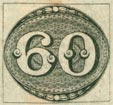
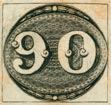 1843. 30, 60 & 90 Reis.
1843. 30, 60 & 90 Reis.
These stamps have always been rather uncommon, especially the 90 Reis; but the forgeries are to be seen everywhere, and I suppose there are few of my readers who cannot remember having been taken in by them, before arriving at what I call “years of suspicion”. From the comparative scarcity of the genuine, and the many years which have elapsed since they were issued, it might naturally be supposed that there would be many imitations in circulation; but I have only met with seven varieties, though one of them, as I said, is extremely common. I must confess that it is a task of no common difficulty to describe these forgeries in such a manner as to enable the possessor of one solitary specimen to say at once whether it be genuine or forged; for, as the design is nothing but a couple of figures, or rather a figure and a cypher, on an engine-turned ground, there is really nothing to lay hold of. However, I will do my best, and ask my readers to make all due allowances.
Genuine
Engraved in taille-douce. There are two distinct issues of this set of stamps: the first on thick, yellowish-white paper; and the second on thin, bluish-white paper; both wove. There is a black rectangle, formed of one single line, drawn round each stamp, and touching it in one or more places. There is a white ball in the outline, at the top of the stamp, and a similar one at the bottom of the stamp, each being fairly circular, and measuring about 1 1/4 mm. across. Each side of each ball there are bunches of white leaves, graduated in size, to fit the diminishing border, and arranged 3:3:3:1, in each case, with a pair of white dots, like a colon, separating each bunch from the following one. Immediately inside the border, there is a band of very light-coloured engine-turning (the lightest part of the whole background) showing two long dark dashes, somewhat diamond-shaped and close together, alternately with two long dashes, wide apart, with a black dot between them. This alternate pattern goes, of course, right round the stamp, as do all the interior patterns now to be described. Inside this light band is a broad dark pattern, composed of tiny, diamond-shaped black dots, formed by the intersection of the white lines of the engine-turning; and these black dots are arranged in alternate large and small diamonds, of 9 and 12 dots, respectively. The division between this and the next section of the pattern is a band showing, alternately, five and four parallel dark dashes, but this band does not look at all like a chain. Inside this comes more of the pattern of diamonds of diamond-shaped dots; then another band of the five and four parallel dark dashes; then some more of the dotted pattern; then a very small oval, the outer outline of which is formed by small dashes and colons alternately, and the inner one an unbroken black line. In the center of all, there is some more of the dotted pattern. It will be understood that only portions of all these various oval patterns can be seen; the rest being hidden by the numerals, except the light-coloured band immediately inside the ornamental frame. There is a very thin black outline following the curves of the thick black shading of the numerals, leaving a very narrow light space between shading and outline.
The special points of difference for the different values are the following:
30 Reis. Genuine
The tail of the 3 is split up into two curls, like those in the tail of a black grouse. These two curls are level with each other. There is no line of shading in the white part of the straight, pointed commencement of the 3. The little white ornamental ball at the top of the stamp is round, while the corresponding one at the bottom is generally an upright oval.
60 Reis. Genuine
The top of the figure 6 ends in a curl, which forms an almost perfect white circle. The ornamental white balls, at the top and bottom of the stamp, are rather larger than those on the 30 Reis.
90 Reis. Genuine
The ornamental white balls, at top and bottom, are large and perfectly round. The shading inside the head of the 9 only goes half-way round, and the portion of the background seen through the head has hardly any pattern on it, except plain, crossed lines of white.
First Forgery
Lithographed, on very thick, yellowish-white laid paper. Copies with a wide margin show two black lines round the stamps, 1 mm. apart. The two white balls are too small, being barely 1 mm. in diameter. The bunches of leaves are thin and “scraggy”, as compared with the genuine. The part of the design immediately inside the border is very dark. It is composed of two long parallel dashes, and two dots alternately, all the way round. Next comes a pattern of dots (more or less round) arranged in diamonds, of nine dots each. The division between this and the next section of the pattern is a white chain, on a black ground. The chain is quite distinct and unmistakable. Inside this is a dotted pattern, but the dots are not arranged in groups. Inside this is another chain; then a dotted pattern, not in groups; then a third chain (this can only be seen clearly in the 90 Reis); and then some more dots, very often blotched into one dark mass. There is a distinct, very prominent white outline round the shaded parts of the numerals.
The special points of difference in the three values are:
30 Reis. Forged
The right curl of the tail of the 3 is slightly but sensibly lower than the left one.
60 Reis. Forged
The curl at the top end of the 6 is an oval, instead of a circle. The ornamental balls at the top and bottom of the stamp are smaller than those of the genuine 30, a great deal smaller than those of the genuine 60, and the same size as those of the forged 90.
90 Reis. Forged
The balls are the same size as those in the forged 60 Reis. The chain-pattern is very distinct behind the center of the cipher. The shading inside the head of the 9 goes quite three-quarters of the way round. There are two very distinct links of the chain-pattern in the background, as seen through the head.
Second Forgery
Lithographed, on rather soft, moderately stout, yellowish-white wove paper, and also on thick, hard, yellowish-white, transversely-laid paper. The white balls vary in size, from 1 to 1 1/2 mm. in diameter. The pattern immediately inside the ornamental frame is composed of parallel pairs of long black dashes (the inner one of each pair generally shorter than the outer one) alternating with colons, but the colons are irregular, and cannot be traced all the way round the stamp. The dotted pattern inside this is not divided into diamonds, but rather into oblique strips, three dots broad. Inside this comes a narrow pattern which, in the 30 Reis, is like a very badly-made chain-pattern above the numerals, but below them is composed of sets of four black dashes. In the 60 Reis, this pattern shows the sets of four black dashes, both above and below the numerals. In the 90 Reis, it is a very thin white chain, both above and below the numerals. Inside this is a dotted pattern, not divided into groups in the 30 and 90 Reis, but divided into squares of 16 dots in the 60 Reis. Then comes a narrow band of sets of three black dashes, above and below the numerals in the 60 Reis, sets of three above and two below, in the 30 Reis, and a thin white chain in the 90 Reis. Then there is another dotted pattern, not divided into groups; then an irregular chain; then some more of the dotted pattern ; then a white line in the 30 Reis and 90 Reis, a little more of the chain-pattern, and a central white dot. Most of this last portion is hidden by the numerals in the 60 Reis. The thin black line, outside the shaded portions of the numerals, is hardly to be noticed in this set of forgeries.
The special points of difference for the different values, besides those already mentioned, are the following:
30 Reis. Forged
The left curl of the tail of the 3 is much higher than the right curl. There is a little black line of shading in the white part of the straight, pointed commencement of the 3, which is not visible in the genuine.
60 Reis. Forged
The top curl of the 6 is almost circular. The head bends over so much, that the dark shading on it actually touches the shading of the body, though it does not do so in the genuine.
90 Reis. Forged
The triple bunch of leaves, at the bottom, furthest to the left from the ball, is badly done, the upper leaf of the three being not much more than a white dot.
Third Forgery
Lithographed, on medium, bluish-white wove paper. As all the white spaces between the dots are exaggerated, this gives the whole stamp a grey appearance. The white balls seem to vary in size from 1 to 1 1/2 mm. This forgery may be easily detected by the bunches of leaves in the lower border, as there is an extra single leaf on each side, making them 3:3:3:1:1 each side, instead of 3:3:3:1. The pattern immediately inside the border has diamonds of from 16 to 25 dots each, with very marked and wide spaces between the diamonds; immediately inside the ornamental border, there is a row of dashes; these vary considerably, some being single, some double, and some triple parallel dashes, the inside one of each double or triple dash being generally the shortest. Inside this, there is a pattern of diamonds of dots, each diamond containing from 16 to 25 dots, with very prominent white spaces between the diamonds. In many of the diamonds, some of the rows of dots are blotched into a single black line. As the extra single leaf at each end of the lower wreaths is such a very marked test, I think further description is not necessary. The special variations for the different values are :
30 Reis. Forged
The right curl of the tail of the 3 is slightly lower than the other, and the right curl of the 0 is decidedly smaller than the left curl, though they ought to be about equal in size.
60 Reis. Forged
There is a zigzag, dotted line outside the outermost diamonds of dots at the top of the stamp, inside the border, extending over about ten of the diamonds.
90 Reis. Forged
There are 19 dots, 4 oblique lines, and several blotches to be seen inside the head of the 9. In this set there are two rectangular frame-lines round the stamps, 1 1/2 mm. apart.
Fourth Forgery
Lithographed, in very dark, greasy, black ink, on soft, yellowish-white wove paper, rather thin. Of this forgery I have only the 60 Reis; and I have never met with more than the one copy. There is no line forming a rectangle round the whole stamp, as in the originals, and in all the forgeries hitherto described; at least, if there is a frame-line, it is so far from the design that it is cut off in my copy, which is not clipped very closely. At a short distance, the whole stamp, except the numerals, looks dark black. It can easily be detected by the bunches of leaves in the lower border, which are 4:3:3:1, each side of the white ball, instead of 3:3:3:1.
Fifth Forgery
Lithographed, in dark black, on stout, white laid paper. There are two frame-lines round the stamp, 3/4 mm. apart. The white balls are oval, instead of circular, about 1 mm. across the widest part. The pattern immediately inside the ornamental border is composed of pairs of parallel black dashes, alternating with colons (= : = : ). Then comes a pattern of diamond-shaped black dots, quite uniform, and not grouped into diamonds. Then comes a thin white chain, on a deep black background; then some more of the uniform dotted pattern ; then another white chain, like the first; then some more of the uniform dotted pattern; and the centre of the stamp is nearly all black, without any particular pattern on it. The ornamental border, which, in the genuine stamps, gradually diminishes in width towards the sides, so that it is merely a thin black line at each end of the oval, is, in this forgery, quite A mm. broad at each end of the oval. There is an extra white dot, opposite to the point of the last leaf of each wreath, top and bottom, though, in the right-hand side of the bottom wreath, the dot is below the level of the last leaf. These extra dots are not to be seen in the genuine. The special differences are:
30 Reis. Forged
The arrangement of the wreath to the left of the bottom ball is, in my specimen, 3:3:2:1: the head of the 3 is totally unlike the genuine, or any other forgery, having a small curl at the left end, instead of the long, downward-pointing peak; the tail, also, is a single, large white ball, instead of the two black-grouse curls.
60 Reis. Forged
The right upper wreath, in my specimen, is 3:2:3:1:. The narrowest white part of the head of the 6 is not much more than 1/4 mm. broad; but in the genuine, the narrowest white part is fully 1 mm. across.
90 Reis. Forged
The right upper wreath, in my specimen, is very badly done, and seems to be 1:1:1:1:, with only one white colon, and as before mentioned, a white dot after the outer leaf.
Sixth Forgery
This is very poor, and I have only met with the 90 Reis. Coarsely lithographed, on thick, very yellowish-white wove paper. The top wreaths are an easy test. To the right of the ball they are : 3:3:2:2:1; and, to the left of the ball, 3:3:3:3:1 (an extra bunch of leaves in each case). While the top ball measures 1 1/4 mm., the bottom one is less than 1 mm. The pattern immediately inside the ornamental border consists of pairs of dashes only. The general dotted pattern is not in groups. The separations between the different portions of the dotted pattern are thin white dashes, on a black ground. These tests will, I think, be found quite sufficient.
Seventh Forgery
I have not any of this set before me, but can describe them from memory, sufficiently for their detection. Lithographed, on stout wove paper of a yellowish-white. The design is done in two colours. First of all an oval, the size and shape of the stamp, is printed in a decidedly blue, neutral tint, and then the usual forgery is printed on the top of this. Thus all the parts of the design which ought to show white are blue. I think this will be enough to describe the forgery, without entering into details which I do not now remember.
Postmarks
Genuine.—29, very large; even larger than the stamp. Also a blotchy cancellation, which I have not been able to make out. Also a very large double oval.
First Forgery.—I, size of the illustration; also larger.
Second Forgery.— 1, larger ; also 29, large.
Third Forgery. — 38, very large, without numerals; but very often uncancelled.
Fourth Forgery.—Uncancelled.
Fifth Forgery.—A rectangle, larger than 74, with unreadable lettering.
Sixth Forgery.—29, large.
Seventh Forgery.—I do not remember whether this was cancelled or not.
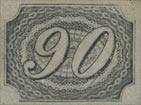
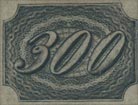 1844. 10, 30, 60, 90, 180, 300 & 600 Reis.
1844. 10, 30, 60, 90, 180, 300 & 600 Reis.
Two sets of these stamps can be made, one printed on yellowish- white paper, and the other on bluish-white, or greyish-white; both wove. The 180, 300, and 600 Reis have always been scarce; but the lower values are common enough. Those on the bluish paper are scarcer than the other set. There is a very great difference in the way in which different specimens of the genuine are printed; some of them are in a rich black, whilst others, which have had, apparently, not enough ink on the plate, look like skeleton, outline copies of the design; and many a collector would be apt to brand these latter as forgeries.
Genuine
Finely engraved in taille-douce; paper varying as above. The design of these stamps is of bewildering intricacy, and yet I shall be obliged to try to describe it, in order to show where the forgeries are at variance with it. Immediately inside the borderline there is a sort of white chain-pattern, formed by the white lines of the engine-turning; but only parts of the oval made by this chain-pattern can be seen; for the oval, if complete, would be larger than the stamp. In the center of each link of the chain there is a black, diamond-shaped dash, with a black dot each side of it. It must be remembered that, of this chain, only a few links (3 to 4) are visible in the corners of the stamp, the rest being supposed to be cut off by the boundary-lines of the frame. Then comes another chain-pattern, similar in all respects, but nearly complete, being only cut off just at the top and bottom. Then comes a lace-work pattern, and then a very white oval, of wavy outline, which is the whitest part of the design. Then there is some more lace-work ; then a narrow black line; then a broad, greyish band, 1 3/4 mm. broad, ornamented with shadowy-looking crosses. Within this, there is a narrow band of lace-work, then a whitish zigzag pattern, then a black zigzag pattern, then the narrow central oval of engine-turning, and finally a straight black line in the center of this. The whole pattern has the appearance of white lines, scratched out of a black background. The shaded parts of the numerals are very black, and the ink of the said shaded parts stands out in relief from the paper, so that the ridges can be actually felt with the finger.
First Forgery
Lithographed, on thick, hard, yellowish-white wove paper. The whole stamp has a very grey look, like an exaggeration of the faintly-printed specimens of the genuine, and the whole of the design is evidently formed by black lines on a white ground, instead of looking like white lines, scratched out of a black ground. Immediately inside the frame is a pattern of white diamonds, on a dark ground. These diamonds only show at the corners of the stamp, the rest being supposed to be cut off by the frame. Then comes another similar pattern of white diamonds, but running all round the stamp, except at the top and bottom. Then comes a pattern of interlacing, outlined crescents, this pattern being rather more than 1 mm. wide. Then comes a dark band, nearly 1 mm. wide, composed of crossed lines, set so closely together that the band appears to be solid black at a distance. Then comes some more of the interlaced crescent pattern, with the crescents turned the opposite way to the others. Then comes a narrow white line, bounded by fine outlines; then a pattern of plain, crossed lines; then another narrow, white line; then some more of the plain, crossed lines; then another white line, not so distinct as the other two; then some more of the plain, crossed lines; and finally a straight, white line in the center. The shading to the numerals is no darker than the rest of the stamp (though it is much the darkest portion in the genuine), and of course the ink does not stand up from the paper at all.
Second Forgery
This may be only a variation of the one just described. It is lithographed, on thick, hard, very yellowish-white wove paper. The tests are as in the first forgery, except that the outermost portion of the pattern seems to show portions of three or four sets of white diamonds, instead of two, and the narrow white lines of the first forgery are black in this counterfeit.
Third Forgery
Of this set I have only the 300 and 600 Reis, and I have known them only for the last ten years. Apparently engraved in taille-douce, on thin, hard, very grey wove paper. In the top left-hand corner and the bottom right-hand corner there are three rows of coarse, very distinct chain- pattern, with a more or less oblong or diamond-shaped black dot in the center of each link. In the other two corners there are only two rows of this chain-pattern. The pattern reminds one of strings of very short, stumpy sausages. At the top of the stamp, there is only one row of the chain-pattern to be seen, and at the bottom, under the numerals, the rows cannot be traced; but it seems almost as if the chains had been thrown together, in a confused heap. Inside the chain-pattern, above the numerals, there is a thing like a long, arched cloud, or more like the connected puffs of white steam from a locomotive. This cloud is shaded with some light black dots. The cloud has a background of black scratches, crossing each other obliquely. The same scratches are to be seen below the numerals, but there is no cloud there. Behind the numerals there is hardly anything to be seen at all, except one or two portions of lines. It will be seen that, although this forgery is in taille-douce, it is not dangerous. The colour of the paper is almost a neutral tint, not white at all.
Fourth Forgery
Of this I have only the 180 Reis. Apparently engraved in taille-douce, on thick, pale buff wove paper. This is exceedingly like the forgeries just described, and all the tests just given will hold good for this counterfeit, except that the cloud above the numerals is more continuous, instead of being like the connected puffs of a locomotive, and that the background, behind the numerals, is covered with a number of scratches, in no definite pattern. The mark in the centre of each link of the chains is, in many instances, composed of two, or even three, thin black dashes, blotched together.
Fifth Forgery
This is new to me (1902) and the best of the lot. I have only the 300 and 600 Reis. Engraved in taille-douce, on greyish-wove paper, about the same substance as the genuine. The chain-pattern is much too white and prominent, each link containing a dark black, diamond-shaped dash. The inner chain is more complete than in the genuine, being scarcely interfered with by the top and bottom outlines of the stamp. There are markings in the centre of the stamp, reaching nearly as high as the numerals, which look like a sort of skeleton Union Jack. The ink stands out from the paper even more than in the genuine stamps. If it were not for the too-prominent chain-pattern, this forgery would be decidedly good.
Sixth Forgery
These stamps are not nearly so good as any of those already described, but they are very common, and seem to form part of the usual stock-in-trade of every swindler. All the values are found in this set. The characteristics of this counterfeit are, that almost the whole of the design, except the numerals, is formed by black dots, and the said design, including the numerals, looks as though the ink had run, giving it a woolly, misty appearance. Lithographed, on very thin, white wove paper. The outer chain-pattern (3 links in each corner of the stamp) is absolutely white, and each link has a straight dash in the centre of it. The inner chain-pattern is very similar, but most of the dashes in the links on the left side of the stamp have a dot each side of the dash. Between the two chain-patterns there is a dotted groundwork, of no particular design. The white oval of wavy outline which comes next is simply formed by the absence of dots. After this is some more of the dotted groundwork, then a black line, then a broad band, nearly all white, but showing some traces of the shadowy crosses of the genuine. Then comes a black outline, then a few scattered clots, and a straight black line in the center of all. The ink, of course, does not stand out from the paper. In this forgery, the left-hand outlines of the numerals are generally much too thick.
Seventh Forgery
Lithographed, on medium, hard, very yellowish-white wove paper. This need not detain us long. The two rows of chain-work have the links diamond-shaped, instead of oval, and the diamonds have 1 dot, 2 dots, 2 dashes, or 3 dashes, as the case may be, in the center of each. Next, after the chain-work, comes the background of a few dots and scratches, then comes an oval, looking something like a bird’s-nest, outlined, inside and out, by dots. Then a few scattered dots, then another bird’s-nest oval, with some dots in the center. The outlines of the figures of value look ragged in parts.
Besides the above, there appear to be two other counterfeits, which are variants of the sixth forgery (probably later editions), but which are covered by the description of the sixth forgery. Some of them vary considerably in the numerals, but the groundwork is substantially the same.
Postmarks
Genuine.—As before. Also a cancellation something like 42, but square, and without numerals.
First Forgery.—Part of a curved line, which is probably 1, very large.
Second Forgery.—The same as the first forgery. Also uncancelled.
Third Forgery.—A very small copy of 42, without numerals, and always struck in red.
Fourth Forgery.—A very small copy of 38, without central numerals, struck in red.
Fifth Forgery. —29, very large; also uncancelled.
Sixth Forgery.—1, very large; 38, without numerals; 41, 100.
Seventh Forgery.—Uncancelled.
Bogus Stamp
180 Reis, Red-brown.
Of course I need not say that no stamps of this issue were ever printed in colours. The bogus stamp of 180 Reis is the type of the seventh forgery of the 180 Reis, black, but is printed in a sort of red-brown. I have only the one specimen (1902), and it is uncancelled.
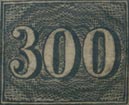
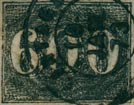 1850. 10, 20, 30, 60, 90, 180, 300 & 600 Reis, Black.
1850. 10, 20, 30, 60, 90, 180, 300 & 600 Reis, Black.
These stamps are found both on yellowish and also on greyish paper. There is a great variety of shade in the ink employed; some specimens are in very black ink, and others merely in grey, but I cannot say whether full sets of each can be made.
Genuine
Engraved in taille-douce, on yellowish or on greyish wove paper, as above, thin and soft, as a rule. The background is the same for all the values, and the design or pattern on this background seems to be of white lines, cut or scratched out of a solid black groundwork. Setting aside the figures of value, there is no black line anywhere in the whole design, except the small, straight horizontal line in the very center of the stamp, and the plain outline of the oval immediately surrounding it; and these are hidden by the numerals in the higher values. The design is not sufficiently pronounced for me to describe it piece by piece; so the fact of there being no black lines in the stamps, except those just mentioned, must be remembered as a principal test. Most of the dots formed by the intersection of the white engine-turning are triangular, and all those which are not triangular are diamond-shaped. There are none of any other form but these two.
The following are the special notes for each value:
10 Reis. Genuine
The white part of the foot-stroke of the 1 on the right-hand side does not stick out so far as the outer edge of the thick shading of the body of the figure. The shading inside the O goes straight down, inside the figure, without curling round at all to shade the top and bottom bends.
20 Reis. Genuine
The white part of the upward bend of the tail of the 2 is perfectly vertical, and is cut off quite square at the end. The white part of the O is exactly the same width on both sides.
30 Reis. Genuine
A line drawn down through the two white balls of the head and tail of the 3 would cut well into the projecting, shaded part of the center of the figure, which sticks out like a sort of tongue. This shaded part is cut off obliquely, sloping down to the right. There are two fairly prominent black triangles between the two numerals, one near the top of them, and the other, inverted, near the bottom of them. The dots in the light part of the center of the 0 are irregular, and not disposed in any pattern, not even in rows. Of the two outlines of the stamp, the inner one is only complete at the sides.
60 Reis. Genuine
The white ball at the top of the 6 curls inwards, until it almost touches the thick shading to the left of it. The white parts of the top and bottom of the 0 are very narrow, and both exactly the same width.
90 Reis. Genuine
There is a mass of thick shading, underneath the lowest part of the head of the 9, and the little white ball at the end of the tail comes very close to the shading.
180 Reis. Genuine
The figure 1 is cut off perfectly square at the top, and has a large white foot-stroke. It is as near to the left side of the stamp, as the o is to the right side.
300 Reis. Genuine
The thick shading of the 3 is so very close to the 0 next to it, that they all but touch each other, and in one of my copies they really do touch.
600 Reis. Genuine
The 6 does not touch the 0 adjoining it. The white ball at the top of the 6 curls inwards, in the same manner as that of the 60 described above. The shaded part of the 0 is almost as near to the right side of the stamp as the 6 is to the left-hand side.
First Forgery
Of this set I have only the 10 and 20 Reis. Lithographed, on rather thick, hard paper, not at all like that of the genuine, but very white, with no tinge of either grey or yellow. The design of the background is composed of black dots and lines on a white ground. The dots are of all sorts of shapes, and the scratchy little lines in the design run through some of these dots. The figures are very clearly outlined, almost as well as in the genuine.
10 Reis. First Forgery
The white part of the foot-stroke of the 1 projects considerably beyond the thick shading, running down the right side of the figure. The thick shading inside the 0 is carried round at the top, so that the whole arch of the top is shaded as thickly as the left side.
20 Reis. First Forgery
The white part of the upward bend of the tail of the 2 leans a little inwards, and is somewhat pointed. The white part of the 0 is a good deal broader on the left side than on the right.
Second Forgery
Lithographed, on very thin, soft paper, much like that of the genuine. The design in this forgery is very much blurred, and no sane collector ought to be taken in by any one of the set for an instant. The figures are all ragged round their outlines, which are very much too thick. Those who know this forgery will recognize it at once, when I remind them that the figures look as though they had been drawn whilst the paper was wet, so that their outlines have “run”. The wavy, ornamental oval, close round the figures, is very much too prominent, and is the first thing which strikes the eye in most of the values; whereas, in the genuine, this particular oval is scarcely noticeable. This forgery is exceedingly common at present; and specimens may be seen in the albums of all our schoolboy friends.
10 Reis. Second Forgery
The figures are like those of the last forgery, but not so clear. They are put too low down on the stamp, so that they are nearer the bottom than the top. Of course I need not say that the figures in the genuine are placed in the center, no nearer to the bottom than to the top.
20 Reis. Second Forgery
I do not possess a 20 Reis of this type.
30 Reis. Second Forgery
The central tongue of the 3 hardly projects at all, and a line drawn down through the two little white balls would pass far to the left of this tongue. The figures are placed far too low down, and too much to the right.
60 Reis. Second Forgery
The white ball at the top of the 6 is a bulb rather than a ball, and it does not curl inwards at all, and is not near the thick shading to the left of it. The figures are placed absurdly too much to the right; the o almost touches the side, whilst there is almost room for another figure to the left of the 6.
90 Reis. Second Forgery
The lowest part of the head of the 9 is simply outlined. There is no shading underneath it. The figures are not quite so much blurred as in most of the other values, but they are placed very much too far to the right.
180 Reis. Second Forgery
This is the worst forgery of the set. The top of the 1 is a blunt, rounded point; the bottom of it ends in a similar point, there being no foot-stroke to it at all. The figures are too much to the right as usual, and the 0 almost touches the right side of the stamp.
300 Reis. Second Forgery
The thick shading of the 3 is at a considerable distance from the side of the 0. The figures are placed too low clown, and rather too far to the right.
600 Reis. Second Forgery
The shading of the 6 touches the side of the 0 next to it. The white ball at the top of the 6 is like that of the forged 60 Reis. The figures are too low down, and rather too far to the right.
Third Forgery
This is printed on laid paper. I have no copies by me, and I cannot trust myself to describe the design from memory; but the fact of their being on laid paper will be abundantly sufficient to condemn them; for no Brazilian stamp of any of the issues hitherto described was ever printed on anything but wove paper.
Fourth Forgery
Of this I have only the 30 Reis, and have never seen any other value. It is by far the best of the forgeries of the adhesives. Apparently engraved in taille-douce, on rather thick, yellowish-white wove paper. A line drawn down through the centers of the two white balls of the 3 would hardly touch the black shading of the central tongue, and this shading is cut off almost perpendicular, with only a very small slope to the right. There are no black triangles between the numerals. The dots in the light part of the center of the 0 are all rather lance-head-shaped dashes, except the top one, which looks like a circumflex accent, and they are in regular, slightly curved, horizontal rows. This is a good test. The two outlines of the stamp are both complete, all the way round. All the white lines are wider, and much more distinct than in the genuine, which makes the stamp much lighter in colour, and causes the numerals to stand out from the background, more distinctly than they do in the genuine.
Postmarks
Genuine.—18, 19, 20, 42 (no numerals), 43, 88.
First Forgery.—Generally uncancelled.
Second Forgery. —37 (no numerals), 62, 76, 100.
Third Forgery.—I do not remember whether this was cancelled or not
Fourth Forgery.—Uncancelled.
1850. 300, 600 Reis, faked.
Some ingenious swindlers cut off the right-hand edge of the common 30 and 60 Reis, and join on a 0 from another stamp, making thus the much scarcer 300 and 600 Reis. When carefully done, the fakes might easily deceive a novice; but of course the stamps are too long, and the 3 and 6 of the genuine 300 and 600 Reis are much nearer the edge of the stamp than the corresponding numerals of the 30 and 60 Reis.
1854. 10 Reis, blue.
Genuine
Engraved in taille-douce, exactly the same design as the black stamps just described, on greyish wove paper. The colour varies from a sort of sky-blue to deep Prussian-blue. The foot-stroke to the 1 is just the same as in the genuine 10 Reis, black. The numerals are placed in the center of the stamp.
First Forgery
The design of this counterfeit seems to be the same as that of the first forgery of the black 10 Reis. The groundwork shows hardly any signs of the ornamental, wavy, concentric ovals seen in the genuine. It is lithographed, on soft wove paper, about the same thickness as the genuine. The pattern is made up of blue dots and scratches, on a white ground. The right side of the foot-stroke of the 1 projects too much, just as it does in the corresponding forgery of the 10 Reis, black. The numerals are placed too low down on the stamp, so that there is much more space above than below them.
I have not seen the 10 Reis, blue, of the types of the second, third, and fourth forgeries of the 10 Reis, black; but of course it is possible that they may exist. In that case, the tests given for the black forgeries will be sufficient to detect the blue ones, if they should turn up.
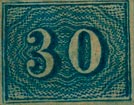 1854. 30 Reis, blue.
1854. 30 Reis, blue.
Genuine
The tests for the genuine 30 Reis, black, will suffice for this. It is engraved in taille-douce, on greyish wove paper, the colour being Prussian-blue, medium to deep, and ultramarine, ditto.
First Forgery
This is the same as the first forgery of the black stamps, and so I should judge that there must certainly exist a black 30 Reis of this type, though I have not seen it. It is lithographed, in dull ultramarine, on thin, hard, yellowish wove paper. The design consists of blue dots and scratches, on a white ground; the dots being of all sorts of shapes, and the scratches run into and through some of the dots. There is no shaded projection in front of the middle tongue of the 3, and a line drawn down through the two balls of the 3 (which, in this case, would have to slope very much to the left, on account of the lower limb projecting too much) would pass far to the left of the projecting tongue. The two large dark triangles between the numerals are absent. Both outlines of the stamp are perfect all round.
Second Forgery
This is uniform with the second set of the black forgeries, and has the same blurred appearance. It is lithographed, on yellowish wove paper, moderately soft, and a little thicker than the genuine. The tongue of the 3 projects a good deal further than in the genuine, so that a line drawn down through the balls would cut into the white part of the tongue. The dark shading of the top ball touches the tongue. The numerals are placed too much to the right, and rather too low down. Both outlines of the stamp are complete, all the way round.
Third Forgery
Lithographed, in blue dots and scratches, on a white ground; design very similar to the second forgery; paper exactly the same. The tongue of the 3 is very short, compared with the second forgery, and it is blunt, and cut off square. A line drawn down through the balls would not go near the tongue. The numerals are very nearly in their proper position, but the bottom of the 3 comes down a good deal lower than the bottom of the 0. Like the last, this forgery is in ultramarine.
Fourth Forgery
I have only seen this lately (1902), but it is evidently a transfer from the design of the fourth forgery of the 30 Reis, black, and the tests for that counterfeit will be abundantly sufficient. It is nicely lithographed, on thick, very hard, yellowish wove paper. The colour is a pale ultramarine.
Postmarks
Genuine.—As before. First Forgery.—Uncancelled. Also 62.
Second Forgery.—Uncancelled. Also 32 (no numerals).
Third Forgery.—76. Some of these seem to have had this cancellation really stamped upon them, with green ink.
Fourth Forgery.—Uncancelled. Also penstroke.
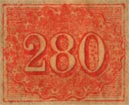 1854. 280 Reis, red.
1854. 280 Reis, red.
Genuine
Engraved in taille-douce on thin, greyish wove paper. The ink stands out well from the surface of the paper, especially in the thick shading of the numerals. The central oval is formed of an engine- turned design, with a very distinct, wavy outline. This outline touches the boundary-line of the stamp in four places; viz., to the left of the 2, above and below the 8, and to the right of the 0. Some copies are so heavily printed that, occasionally, other parts of the wavy outline almost touch the boundary-line, besides the four above-mentioned; but there can be no mistake about the said four. The 8 and the 0 are very deeply shaded. Not counting the outline of the stamp, there are 15 horizontal lines in the left top corner, 16 in the right top corner, 15 in the left bottom corner, and 14 in the right bottom corner. Between the thick outline of the stamp and the stamp itself, an excessively thin line may be traced, all up the left side, and half-way up the right side. The colour is a deep red-vermilion, rather dull.
First Forgery
Lithographed, on very thin, very white wove paper. There is very little attempt at any imitation of the engine-turned central oval; but the said oval is marked by a very prominent chain-pattern, more like a string of sausages than anything else. There is, of course, no indication of the ink standing out from the surface of the paper. The chain-pattern touches the outer border-line, to the left of the 2, and to the right of the o, and two of the scallops touch under the 8, and none at all at the top above the 8. The centers of the 8 and of the o are very lightly shaded. There are only 14 horizontal lines in the left top corner, 15 in the right top corner, 12 in the left bottom corner, and 13 in the right bottom corner, though one of these last is sometimes blotched and hidden.
Second Forgery
I fancy this forgery is not often to be met with; I have only seen two specimens, during all the years I have grubbed among these Album Weeds. I have put it second on my list, because the one just described is so much more common ; but I think it is highly probable that this latter forgery is the older of the two. Lithographed, on rather thick, bluish-white, or on medium, very yellowish wove paper. There is no thickness of ink to be seen on the surface of the paper. The 2 and the 0 are much larger than the 8, and come considerably below it. The center is composed of slightly curved, crossed, radiating lines, surrounded by an oval of very pointed scallops, not a bit like the rounded, wavy outline of the engine-turned oval in the center of the genuine stamps. None of the scallops touch the outer boundary-line, except the one to the right of the 0. There are 26 horizontal lines in the left top corner, about 17 or 18 in the right top corner, 23 in the left bottom corner, and about 27 in the right bottom corner. One of my copies has a red blotch in the left top corner, but this is not visible in my other specimen. The colour of one copy is a dull, dirty orange-vermilion; the other is more a sort of deep brownish-carmine.
Postmarks
Genuine.—As before.
First Forgery.—5, 101.
Second Forgery.—51; also some blotches.
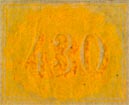 1854. 430 Reis, yellow.
1854. 430 Reis, yellow.
Genuine
Engraved in taille-douce, almost exactly like the 280 Reis. outline of the central oval of engine-turning touches the outer borderline in three places only; viz., to the left of the 4, and above and below the 3. There are 15 horizontal lines in the left top corner, 16 in the right top corner, 16 in the left bottom corner, and 16 in the right bottom corner. The engine-turning, as in the 280 Reis, is almost equally dark all over. The colour is what I should call “lemon”, and it becomes almost orange where the ink is very thick, though the hue is given as “yellow” in the catalogues.
Forged
Lithographed, on very thin, very white wove paper. There is a string of sausages, or chain-pattern, as in the first forgery of the 280 Reis, and this pattern only touches the outer boundary-line in two places; viz., to the left of the 4 and below the 3. The ink does not stand out from the surface of the paper. There are about 14 horizontal lines in the left top corner (the two top ones being usually blotched together), 16 in the right top corner, 13 or 14 in the left bottom corner, and 9 or 10 in the right bottom corner. The colour is a dirty yellow-ochre, very pale and chalky, and quite different from the genuine.
Postmarks
Genuine. —As before
Forged.—4, 5, 54 (all without numerals), 101.
1866. The Stamps of 1850-4. Perf. 13 1/2.
Genuine Stamps, with Genuine Perforations
These are the stamps of the two issues just described, but perforated. The gauge is 13 1/2, which must be borne in mind.
I have only a very few specimens of the genuine, so I cannot be sure that the size of the stamps, as cut out by the perforating-machine, is always the same; but my copies, from outside to outside of the whole stamp, measure about 23 1/2 x 18 1/2 mm.
Genuine Stamps, with Forged Perforations
The forgers have taken genuine stamps, both used and unused, and added perforations to make the specimens more valuable. I have the following gauges: 9, 10, 11, 11 1/4, 11 1/2, 11 3/4, 12, 12 1/2, 13, 13 1/2, 14, 16, 18, also some irregular ones, with all the sides varying. The stamps seem to be distinctly smaller than the genuine, as might be expected. The measurements, from outside to outside of the whole stamp, vary from 21 x 15 mm. to 22 x 17 1/2 mm.
Forged Stamp, with Forged Perforations
I have the first forgery of the 10 Reis, black, perf. 12 1/2 x 13; the stamp measuring 21 1/2 x 16 1/2 mm. This is the only perforated forgery that I have ever seen.
Postmarks
Genuine Stamps, with Forged Perforations.—These, of course, bear genuine cancellations.
Forged Stamp.—This is uncancelled.
1867. Envelope Stamps. 100, 200 & 300 Reis.
The forgers seem to have reserved their best efforts for the last, as the counterfeits now to be described are certainly far finer than any of the forgeries above-mentioned. Usually, embossed stamps do not tempt the forgers much, on account of the difficulty attending their production; but the embossing of these counterfeit envelopes is very well done, though I do not know how it has been managed. These stamps strikingly exemplify the advisability of collecting entire envelopes, as the watermark on the genuine cannot be imitated, though it can never, or “hardly ever”, be seen on a cut stamp. With reference to this matter, I think I must say that most of the blame for the mutilation of envelopes must be laid upon the shoulders of the album-makers; for they leave no space in their books for the collection of entire specimens, so that those who are what I call slaves to their albums have no choice but to cut their envelopes, to make them fit the little squares provided for them.
Genuine
Engraved in epargne, on white laid paper, with the lines running obliquely, and watermarked, in large letters, with the words CORREIO BRASILIERO, in two lines, extending almost across the envelope from one side to the other. There is nothing special about the envelopes, except that they are rather large—162 x 92 mm., or thereabouts. The flap is plain and rounded, and is gummed almost from end to end. The emperor’s nose is rather small, pointed, and perfectly straight. The profile of the beard has two waves in it; that is to say, it is rounded outwards from the under lip, then goes in again slightly, and then projects outwards once more. The hair on the top of the head is smooth. The point of the bust in front is almost as sharp as the point at the back. I must take the special variations for each value separately.
100 Reis. Genuine
For the tests now to be given the reader must provide himself with something having a straight and flat edge, such as a sheet of paper, or a flat rule. If the rule be laid exactly along the center of the letter I in REIS, it will just touch the B of BRAZIL. In the figures of value on each side, the 1 of 100 is nicely drawn, with a long up-stroke or side-stroke, and a very distinct foot-stroke showing on each side of the figure.
200 Reis. Genuine
If the rule be laid along the center of the I in REIS, it will pass through the value-label on the left hand, and will just touch the top of the last 0 in 200; and if the rule be laid along the center of the I of BRAZIL, it will cut through the E of DUZENTOS. The O of this latter word is round, which will be found a good test.
300 Reis. Genuine
If the rule be laid along the center of the first stroke of the B in BRAZIL, it will cut into the E of REIS. The 3 of 300, on each side of the head, is at some little distance from the outline of its containing-label.
Forged
There are two sets of forgeries, one of them much more likely to deceive than the other; and I really think that the better one of the two might easily deceive anybody who did not happen to have genuine stamps by him to compare. I will take the inferior forgery first, as it was the first to appear.
First Forgery
Embossed on thin, white wove paper; no watermark. The nose has a sort of drooping point to it, even sharper than the genuine. The hair on the top of the head is very untidy. The curve of the beard beneath the chin is wavy, whereas, in the genuine, it is a smooth curve. The wavy profile of the front of the beard is exaggerated, the middle wave projecting beyond the level of the end of the nose. The point of the bust, in front, is rounded.
100 Reis. First Forgery.
The rule, when laid along the center of the I in REIS, will not touch the B of BRAZIL, but falls to the left of it. In the figures of value on each side, the I has scarcely any side-stroke, and only a very small foot-stroke.
200 Reis. First Forgery.
The rule, laid along the center of the 1 in REIS, will not touch the left-hand value-label, but goes to the right of it; and, if laid along the center of the 1 of BRAZIL, it will hardly touch the E of DUZENTOS. The 0 of this latter word is oval instead of round.
300 Reis. First Forgery
The rule, laid along the center of the first stroke of the B in BRAZIL, will pass through the I of REIS. The 3 of 300, on each side, almost touches the boundary-line of its containing-label. There is a small white dot between the N and T of TREZENTOS, and another between the E and I of REIS. Of course I need not say that these dots do not appear in the genuine stamps.
Second Forgery
Very well embossed, on very thick wove, and on moderately stout, laid paper. The copies on laid paper have the laid lines running vertically, from top to bottom, instead of obliquely. The hair on the top of the head is tidy, as in the genuine. The bust is rather blunt in front, but very sharply pointed behind. The beard, in profile, is composed of two curves only, one smooth curve from the ear to the point of the beard, and another smooth curve from the lip to the point of the beard. The moustache is very highly embossed, and stands out higher than in the genuine. But the chief test of these forgeries is the nose, which is of a thoroughly Jewish type; a regular “beak”, with a rather blunt and rounded point, instead of the straight, Grecian type of the genuine.
100 Reis. Second Forgery
The rule, laid along the I of REIS, runs a long way to the left of the word BRAZIL. The 1 of 100, on the left side of the stamp, has only half of its foot-stroke visible; i.e., the right-hand half.
200 Reis. Second Forgery
I have not seen a 200 reis of this set, but the nose will condemn it, if there should be a forgery of this type.
300 Reis. Second Forgery
Not quite so highly embossed as the 100 reis. The N of TREZENTOS is badly drawn. The lettering and figures are almost exactly the same as in the genuine 300 reis, so that, if it were not for the Jewish nose, this forgery would be very dangerous.
Postmarks
Genuine.—18, 19. Also 29, with name between the circles, and date in the center, with (generally) a small star at the bottom.
Forged.—Uncancelled. I conclude that the manufacturers were so pleased with their handiwork, that they thought it a pity to spoil it with a postmark.
I would certainly recommend my readers to be careful about purchasing these envelopes in a cut state. When entire, the watermark can be seen on the genuine, and that will settle their authenticity at once, without laborious comparison.
From: ‘Album Weeds’, 3rd edition by R. B. Eareé. 1906
 See also:
See also:


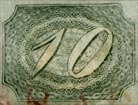
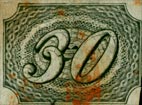

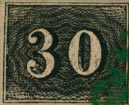
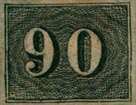
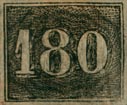
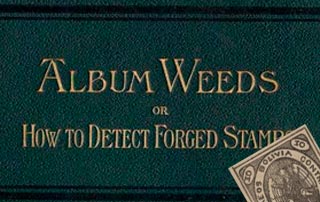


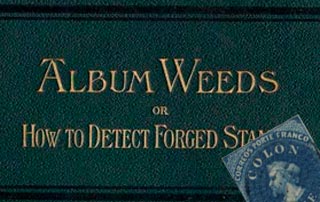
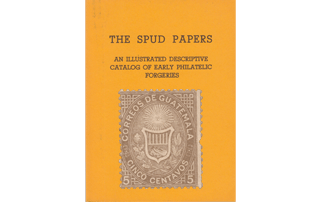
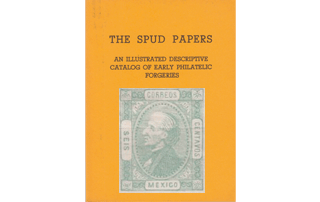
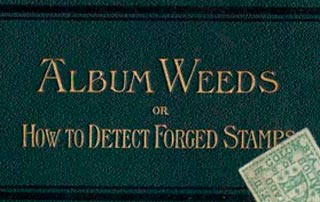
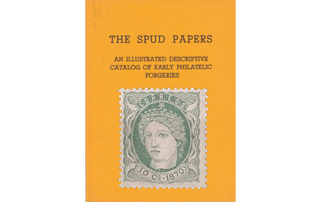
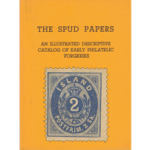
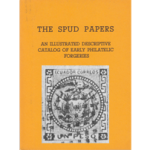
Leave a Reply
Want to join the discussion?Feel free to contribute!